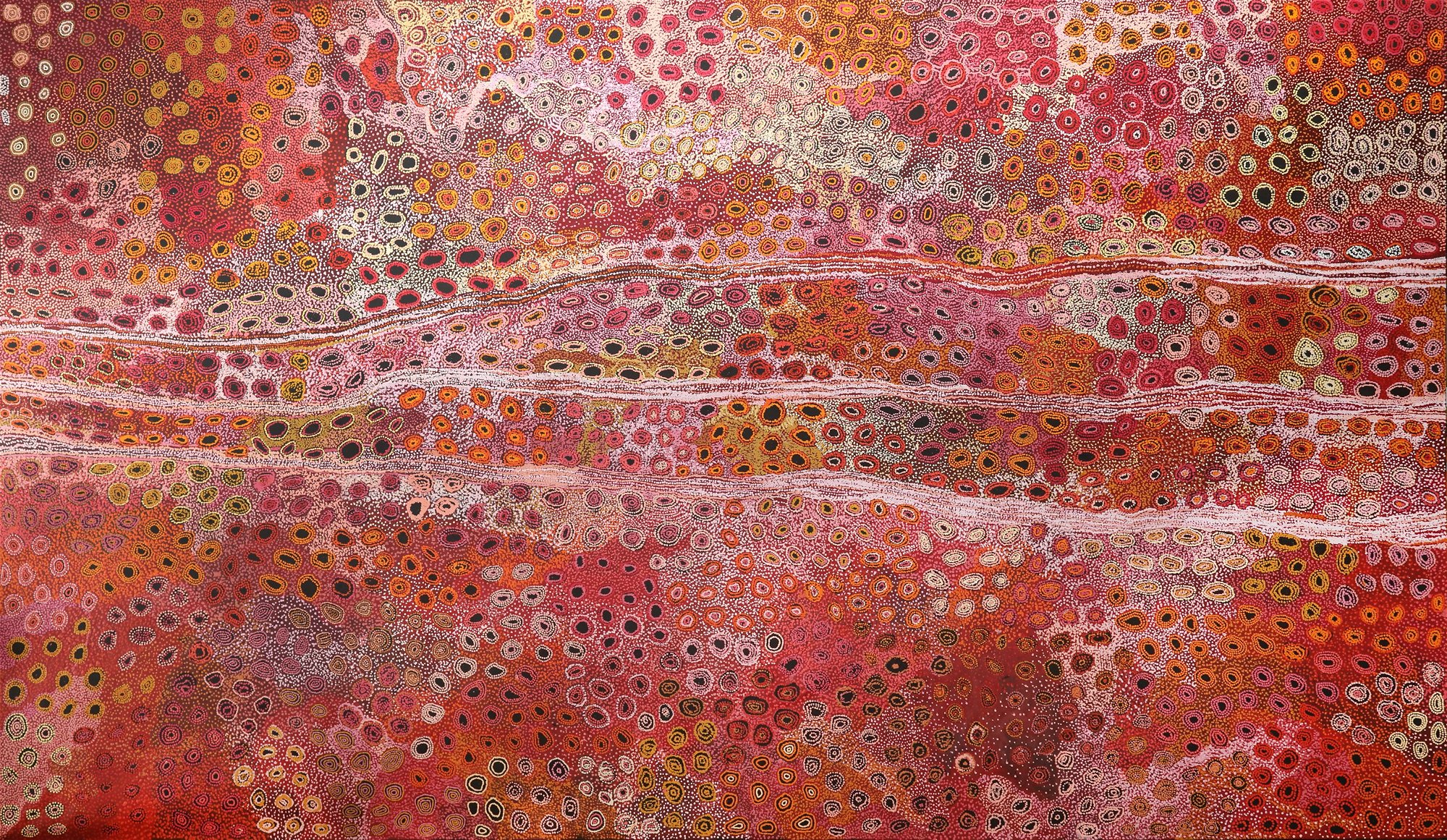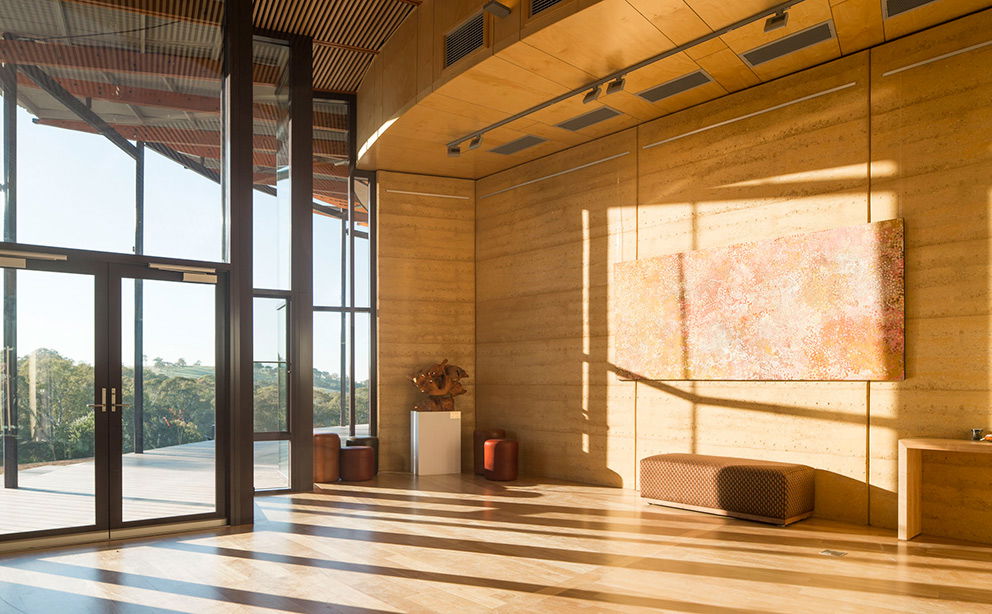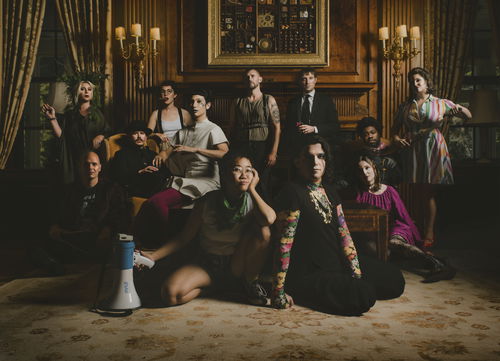
Foyer
Every aspect of the foyer has been designed to create a sense of invitation. Rammed earth walls are bathed in natural light – preluding the events inside the hall – whilst environmentally sustainable timbers exude natural, rural warmth.
The centrepiece of the foyer is Seven Sisters, painted by the Mitakiki Womens’ Collaborative, commissioned by UKARIA and acquired through the APY Art Centre Collective with the generous support of Ulrike Klein AO.
Seven Sisters
(installed in foyer, October 2021)
Artist: Mitakiki Womens’ Collaborative: Mona Mitakiki Shepherd, Naomi Kantjuriny and Tjimpayi Presley
Size: 420x240cm
Medium: Acrylic on Belgian Linen
Mona Mitakiki Shepherd, Naomi Kantjuriny and Tjimpayi Presley paint kapi tjukurla (rock holes) that relate to the Kungkarangkalpa tjukurpa. This story involves the Seven Sisters being chased across country by a bad man (Wati Nyiru). The elder sisters protect and teach the younger ones, and keep them from falling for his tricks. Wati Nyiru can change shape into different rock formations and landmarks. These sites remain part of the landscape and are important Anangu ceremonial places.
The Seven Sisters story is very important to Anangu culture, as a story about family and culture. Mona, Naomi and Tjimpayi were taught to paint by senior artist Kunmanara Katie Kawiny. She has passed away but the younger women carry her story on for future generations.
Mona Mitakiki Shepherd | Born 1954
Mona started painting with Tjurma Arts and Crafts back in 1998. After a long break she returned to painting at Tjala Arts (formerly Minymaku Arts) in mid 2003. Mona’s husband, Michael Mitakiki also painted briefly at the art centre. After he passed away in May 2005 Mona changed her surname from Mitakiki to Shepherd for cultural reasons - Pitjantjatjara people are not allowed to see or hear the name of the deceased.
Naomi Kantjuriny | Born 1944
Naomi is a prolific painter who has been working at Tjala Arts (formerly Minymaku Arts) since 2001. An excellent hunter, basketmaker and wood carver, Naomi took to painting with remarkable ease. She is recoginsed for her knowledge of the Tjukurpa stories of the area and whilst she is an emerging artist her technique is well developed. Naomi’s mother’s Dreaming is Malu or kangaroo. Naomi is also a Ngangkari - traditional healer. Ngangkari provide traditional healing treatments and practices of the mind, body and spirit. They are exactly like Western doctors and equal to doctors in their effectiveness for the Aboriginal people of her region.
Tjimpayi Presley | Born 1967
Tjimpayi is the daughter of Tjampawa Katie Kawiny who is also a painter at Tjala Arts. Tjimpayi is well known for her ‘punu’ woodblocks, a process that involves burning the design into a wooden surface using hot wire. However, she is also a talented painter and has recently started making beautiful work on canvas.

Materials in the foyer
‘I don’t think I’ve met anybody who doesn’t like rammed earth,’ architect Anton Johnson says. ‘It’s such an earthy, grounded material.’ Made from locally quarried sand and rubble, the walls are a nod to the old mud-brick building from the Jurlique Herb Farm days, whilst offering a distinctly contemporary feeling of stability.
Blackbutt timber from Queensland is used for the floors throughout the foyer and auditorium for its unique density. ‘It’s one-and-a-half times harder than jarrah, so it can withstand a lot of traffic and wear, and it has a beautiful blonde colour,’ Anton explains. Overhead, a hemlock acoustic ceiling absorbs a significant amount of noise during periods of congestion, and complements the simplicity of the wall and floor surfaces.
The doors to the auditorium are made of yellow cedar from Alaska – a timber chosen for its colour, durability and fine-grained finish. ‘It’s the solid timber that gives the whole place a bit of a glow,’ Anton says. ‘It’s difficult to get and rarely seen, because it has very distinctive qualities in terms of the smoothness of the surface and the lustre that it gives. It is also a popular timber for making classical guitars.’










